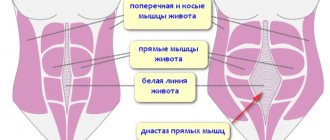What is diastasis
Diastasis rectus abdominis is a condition defined as separation of the rectus abdominis muscle from the linea alba. The disease comes in three stages; the main causes are considered to be:
- Postpartum period.
- Improper physical stress on muscles.
- Pathologies.
- Obesity.
- Genetics.
Some studies have shown that diastasis leads to a number of complications, including abnormal condition, lumbopelvic pain and external defects that lead to problems with the lower body.
Description of the taping procedure
The taping procedure for diastasis can help treat this problem or get rid of it completely. The purpose of the tape is to help treat diastasis rectum and tighten the abdominal muscles.
The tape connects muscles and connective tissue. When the tape is applied to the skin, it stretches and then tends to return to its original “unstretched” position. This continuous stretching process on the skin sends a signal to the connective tissue and muscles to move in the same direction as the band. This technique improves blood circulation and promotes muscle recovery.
After only 3-4 applications of the tape, positive results can be observed. Taping is done for 3–5 days with a break of one or two days.
Taping technique
The technique of taping for diastasis of the rectus muscles may vary depending on the characteristics of the patient. Experts advise starting slowly with a minimal amount of tape to see if there are any allergic reactions or side effects, as well as discomfort when worn. If an allergic reaction occurs, you should stop using it and wait a week. During this period, it is necessary to use a corrective cream for connective tissue. Usually during this time the skin loses hypersensitivity, and you can start the procedure again.
Many people follow this popular ribbon appliqué technique:
- Determine the width of the muscle discrepancy using special tests for diastasis.
- Calculate the length of tape needed to apply to the muscles.
- Cut two ribbons.
- Place the tape in the middle of the abdomen, slightly touching the borders of the rectus muscle.
- With light tension, apply one strip towards the torso line.
Repeat similarly with the second tape. After the procedure, gently smooth the patches with your fingers.
Abdominal taping for weight loss
The principle of operation of kinesio taping is simple and effective. It is based on a deep knowledge of the working mechanisms of the human body. Fixed correctly on the skin, the tape has an effect at the receptor level. It is felt from the first minutes after applying the application. The skin in the taping area receives delicate irritation. This is expressed in a feeling of slight warming and pleasant tingling.
The patch slightly pulls and lifts the skin. This reduces the pressure on tissues and blood vessels in the area of application. The muscles relax and blood flow increases. The movement of lymph also accelerates. Taping helps
- relieve pain in muscles and joints;
- speed up recovery of injured areas of the body;
- speed up metabolic processes;
- activate the fat burning process;
- smooth and tighten the skin.
The aesthetic effect that can be achieved thanks to applications is impressive! Tightening your stomach with tapes and getting rid of the skin-fat apron using taping in combination with other procedures and sports is not difficult. Extra centimeters melt away before your eyes, cellulite is reduced, and stretch marks become less noticeable. Therefore, abdominal taping for weight loss has become very popular.
For example, if we look at the areas that most often become problematic, we will understand that these are the lower abdomen and the waist line. And if it’s easy to make your waist visually thinner with the help of clothes and accessories, then it’s more difficult to hide the excess volume in the lower abdomen. It is also difficult to remove fat deposits in this area using only standard methods - sports and diet. Abdominal taping for weight loss has shown to be highly effective in combination with other methods and helps remove volume even in the most difficult areas!
Application of tapes after childbirth
Taping the abdominal muscles for diastasis after childbirth can be a life-saving solution for mothers. Professional tapes do not contain latex, are hypoallergenic, can be worn for several days, and will not interfere with the mother's daily life, since they do not limit the range of body movements. This makes them a good way to rehabilitate after a difficult birth.
READ ALSO: Experts predict an increase in the number of DDoS attacks during the May holidays
To apply the tape, you need to follow these instructions:
- Cut strips 2.5 cm wide.
- Lie on your back.
- Glue the tapes along the width of the muscles that have been stretched.
- Secure the edges without strong tension.
The oblique muscles need to be taped while sitting. Then the tape is fixed at the level of the spine. The second part of the patch is attached to the costal arch. The injured muscles should be cut with tape.
Application of kinesio tapes
Taping for the purpose of losing weight is carried out in stages, similar to methods for sports use, regardless of the attachment area (on the sides or stomach).
Preparation
The preparation procedure consists of the following steps:
- Examine the skin for damage (scratches, abrasions, pustules).
- It is necessary to remove hair from the area where the tapes will be glued.
- The skin should be clean and dry.
- Before gluing, it is necessary to degrease the epidermis with a cotton pad soaked in alcohol.
Initially, it is recommended to secure only 1 tape for 24 hours to prevent the development of an allergic reaction. If you are not allergic, you can begin gluing the tape using the chosen method.
Pasting
Before gluing, you need to decide in advance on the method of placing the tapes. The shape of the tape depends on this. It is often recommended to buy wide ribbons, as they can be cut to the desired width and given the desired shape.
Next, the gluing process must be carried out in compliance with the following points:
- You need to hold the tape in your hand so that it warms up and becomes more elastic.
- It is advisable to round the edge of the tape, this will reduce the likelihood of the sharp edge of the tape adhering to clothing, followed by its peeling off.
- The paper base must be removed from the tape (not completely).
- Attach the end of the tape without applying tension.
- Gradually remove the paper base and glue the tape without strong tension. It is important not to allow the formation of folds, as they will reduce the effectiveness of the procedure and can provoke the development of irritation.
- The end of the tape is also fixed without tension.
- The ends of the tapes should only be attached to the skin and not to another tape.
Upon completion of the procedure, run your hand over the tape to eliminate wrinkles and air bubbles. A check for discomfort is also carried out (the tape should not hinder movement). The gluing procedure can be performed both in a lying and standing position. This does not reduce the effectiveness of the method.
Wearing rules
Tapes can be worn around the clock for 5 days. After this, a break of 48 hours is required. During this period, the skin rests and recovers from prolonged tension. After gluing the tape to the skin, physical activity is allowed after 30 minutes. After taking water procedures, tapes should be carefully blotted with a towel, without rubbing.
If the tape “falls off” before 5 days, it is necessary to replace the tape. If only the edge comes off (no more than 2 cm), then it can be cut off; the tape is not removed. The total period of constant wearing should not exceed 5 days.
Removal
The procedure for removing tape from the skin is carried out sequentially:
- The tape (it must be dry) needs to be soaked with a special compound and left for 10 minutes. If the tape does not detach well from the skin, you need to wait another 5 minutes.
- Unfasten the tape from the skin at an angle of 20-30 degrees with smooth movements. During removal, the tape is rolled into a roll so that it does not re-attach to the skin.
- Rinse and dry skin.
- To improve the condition of the epidermis, it must be lubricated with a nourishing or moisturizing cream.
Reused tape is prohibited from being used, as it has lost its elasticity and good adhesion to the skin.
How to remove tapes
Patients leave the tape on for a few days if it is comfortable and helps support the core, but then it must be removed. To remove taping tapes for diastasis recti, it is best to contact the specialist who applied them.
However, if there is a need to urgently remove the tape, experts advise removing the tape slowly in the direction of hair growth. For tape that is difficult to remove, you can apply a large amount of oil. You need to wait for the oil to be absorbed. Then continue to remove slowly, trying not to touch the hair.
How to choose tapes
After studying the taping procedure for diastasis and reviews, you can decide whether tapes are needed or not, and also choose the best type for a particular problem. Super elastic bands are best because they are easy to apply. For best results and a greater range of motion, you should choose a band with an elasticity of 160% or more. Kinesiology tape is usually sold in a roll, so it must be cut to size before application.
Contraindications to kinesio taping
You cannot use elastic patches at your own discretion. If applied incorrectly or if there are contraindications, they can cause harm instead of benefit. Here are the diseases and conditions for which taping is not recommended:
- diabetes;
- renal failure;
- thrombosis;
- skin diseases;
- pathologies of the cardiovascular system;
- tumors;
- current infectious and inflammatory diseases;
- fractures and other reasons.
An experienced doctor will warn you in which cases you should refrain from taping. If precautions are not followed, serious health problems can occur. Before you start using patches to achieve weight loss on your stomach and sides, you should weigh the pros and cons and consult a specialist. On the Internet you can find many reviews that users share about their experiences.
Effect after the procedure
Physiotherapists confirm the effectiveness of the tapes with regular use. As a result, the skin over the tense, knotted muscles is lifted and the muscles are pulled back together. The procedure is effective because the tape supports the abdominal line, acting as connective tissue. This way the torso muscles are stabilized and can withstand physical stress.
Kinesio taping is a good option for abdominal muscle diastasis, as well as for expectant mothers who want to get rid of pregnancy-related complaints. Methods of taping for diastasis and the technique of its use can also be found in videos on the Internet. To learn more about this method, it is worth checking them out and learning more about this procedure and the methods of applying tapes.
How does the kinesio taping system work?
This is what begins to happen in the body when using elastic kinesio tapes:
- Reduced blood pressure. In the area where the tapes are glued, an area of low pressure is created. Lymph and blood flow are accelerated, thus increasing the amount of oxygen supplied to cells and tissues, which contributes to a faster removal of toxins and breakdown products.
- Taping ensures the correct direction of lymph movement. Even with active training, excess belly fat can provoke stagnation of lymph in the intercellular space. But it is precisely the excess fluid in the body that often prevents weight loss. The patches prevent this undesirable phenomenon by normalizing the functioning of the lymphatic system, helping to effectively relieve swelling.
- Tapes improve blood supply to tissues. As a result, they receive more oxygen needed to burn fat reserves.
- After intense physical training, which is done to lose weight, not only muscle fibers are stretched and compressed, but also the skin. In this case, adhesions may occur in the connective tissue, leading to stretch marks, swelling, and pain. Taping prevents their formation.
The use of elastic patches helps prevent muscle strain during sports activities, injuries to ligaments and joints. It is known that calories are burned well during active physical activity. The use of tapes allows this process to be carried out with minimal risks.
Of course, the patch itself is not a magic remedy that just sticks on your stomach and its volume will decrease. The taping method must be combined with an active lifestyle, suitable sports activities, and proper nutrition. At the same time, fat reserves will gradually decrease, and muscle mass will remain in order.
A detailed overview of the kinesio taping method, video instructions and reviews on the use of kinesio tapes in this article.










